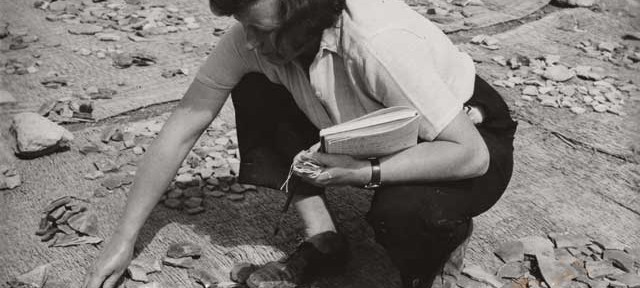by Tuula Tynjä
Differences in texts are traced by reading closely manuscripts and comparing them – this work reveals changing patterns in thinking and society. Ideological, social and economic changes also leave an imprint on material culture, which is the focus of archaeological study. Changes in material culture are traced by examining material remains and comparing them with each other. These remains include various things, like settlement patterns, temples, domestic houses, lithic tools and pottery fragments.
Pottery was introduced in the Levant during the latter part of the Neolithic (ca. 6000–4500 BCE). Since then, pottery was produced for everyday purposes as well as symbolic items. Clay, mixed with tempers and burned to make it durable became a common element of material culture. Due to its abundance and durability, pottery is the most common find group in most archaeological excavations in the Near East. Each excavation working with periods after the Neolithic produces vast amounts of ceramic finds: hundreds and thousands of shards and kilograms. A lion’s share of the work after excavating is dedicated to pottery analysis, appearing as major part in the final reports. These reports describe the pottery by text, drawings and photographs. The material is arranged into functional types and chronological developments are usually suggested.
During the excavation, a first phase of “pottery reading” already takes place. The material from each day’s excavation contexts are first washed, usually during the afternoon. During the next day, the shards are dry and the excavation team examines the material. During this first phase the focus of excavators is often chronological. We are interested to see, if we already have reached a habitation layer that can be identified being of a certain archaeological period. However, many other aspects can be read from the ceramic material.
Many things can be observed from the pottery, like the form, ware, size, color, surface structure. The vessel functions, forming techniques or chronological implications are deduced from such observations. We can study the production techniques and modes of production. The household production methods differ from those of professionalized workshops by their forming techniques, uniformity of the material and the structures build for baking the pottery. For example, building vessels by coiling or pinching and baking in pits are typical for household production, while working with potter’s wheel and building kilns for baking the vessels are used in professional workshop industries. Such themes give us insights to the structure of the society.

The preservation of the pottery material also helps the excavator to interpret the formation process of the specific excavated context. Constructional fills can separated from destruction layers. Fills should include more chronologically mixed material and mainly shards, worn and small. Destruction layers or refuse pits should include larger fragments or even restorable and whole vessels with rather sharp breaks from restricted chronological range.
Space use can be deduced from architectural elements, other structures and artefacts found from the context. Several storage vessels in a room indicate use of a room or part of it for storing, while cooking vessels and hearths or ovens indicate food production area. Synagogues and churches tend to have specific structures and for the ceramic finds, especially lamps tend to be abundant.
In material culture, there are differences between geographic areas and chronological periods. Some of these differences reflect changes in economic, social or ideological conditions. Some of them may well be independent from such conditions. Material culture is an inevitable part of human life. Humans shape materials to make artefacts, while the artefacts surround humans and shape our experience of the world. Materials are read all the time, mostly unnoticed.

